Correction of Irregularly
Arranged Teeth
Correction Of Irregularly Arranged Teeth
Orthodontics is a specialty of dentistry that deals with the diagnosis, prevention and correction of malpositioned teeth and jaws. It can also focus on modifying facial growth, known as dentofacial orthopedics. Abnormal alignment of the teeth and jaws is common.
Correction of irregularly aligned teeth requires proper treatment planning and diagnosis to provide a long term result with good prognosis. We have a competent team of consultants who are well experienced in fixed mechanotherapy.
Sometimes, it is also finding great to use braces for correction of crooked teeth for both top crooked teeth or bottom crooked teeth.
Our Treatments

Metal Brackets
Traditional braces consist of standard metal brackets that are placed on your teeth with an adhesive and connected by wire. They require periodic tightening so steady pressure can gradually straighten your teeth and align your jaw.
Ceramic Brackets
Ceramic braces are similar to metal braces, but they use clear or tooth-colored brackets rather than gray or metallic silver brackets and wires. Many people opt for ceramic braces because they’re less noticeable on your teeth than metal braces. This can be a huge advantage if you’re considering braces and don’t want to feel self-conscious about wearing them.


Lingual Brackets
Lingual braces are similar to traditional braces in that brackets and wires are installed in the mouth and on the teeth to fix misalignments. However, lingual braces differ because they are almost entirely invisible. They are placed on the back of the teeth facing the tongue, rather than the front of the teet
Clear Aligners
Clear aligners, also known as clear-aligner treatment, are orthodontic devices that are a transparent, plastic form of dental braces used to adjust teeth.
Clear-aligner treatment involves an orthodontist or dentist, or with home-based systems, the person themselves, taking a mold of the patient’s teeth, which is used to create a digital tooth scan. The computerized model suggests stages between the current and desired teeth positions, and aligners are created for each stage. Each aligner is worn for 22 hours a day for two weeks.[5] These slowly move the teeth into the position agreed between the orthodontist or dentist and the patient. The average treatment time is 13.5 month

